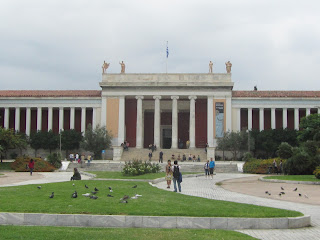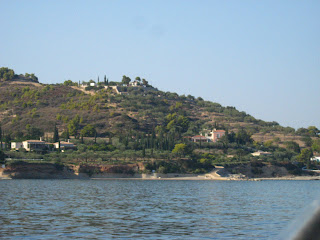I said goodbye to Athens this past
Friday and set out with a group of CYA students and professors to spend the weekend
in two other fantastic Greek towns: Meteora and Metsovo. Located about six
hours north of Athens, Meteora and Metsovo rank as two of the most beautiful
places I’ve ever visited. Both towns have spectacular local landscapes and a
lot of traditional Greek charm. Since we were quite a bit north of Athens, I even
got a taste of the fall weather and foliage that I’ve been missing here in the
southern Mediterranean.
I’m not sure it is even possible to
describe the magnificence of Meteora, but I’ll try to put it into words. This
small area of Greece is known best for its towering rock formations. And as if
that doesn’t sound amazing enough, those towering cliffs are the foundations of
monasteries that date back to the Byzantine period! Of the twenty-four orignal
monasteries that were built in this area, only six survive today. Over the course of the two days we were in
Meteora, our group visited four out of these six working monasteries. Since
they are located on top of island rock formations, getting to these buildings
is no easy feat. Roads can only get so close to the cliffs, so bridges and many
many steps are used to reach the top of the rocks. I was exhausted after just a
day and a half of walking to these monasteries, so I can’t even imagine how
difficult it was to construct and access these places hundreds of years ago! However,
the stairs are well worth the effort. Once
I reached the top of the first monastery, I was overwhelmed by the beauty of
the mountains and cliffs. The view is so beautiful that it almost doesn’t seem
real. In addition to the amazing scenery, the monasteries provide great
examples of Byzantine iconography and manuscripts. Our group was lucky to have
three great professors with us who gave us so much information on the modern
Orthodox Greek Church as well as Byzantine architecture.
After spending most of Friday and
Saturday in Meteora, our group packed up and headed to our next destination:
Metsovo. This small mountain town was the perfect place to spend a fall
weekend. I was so happy to kick my feet through the fallen leaves and sit down
to a warm meal on a cold night. In
addition to spending time looking at the wood-working and cheese shops (Metsovo
is known for these two products), we also visited a local folklore museum where
we got a taste of life in Greece during the 19th century. Before heading back
to Athens on Sunday, our group had the privilege of attending a Greek Orthodox
church service and sitting down for coffee with the local priest. His
congregation was very inviting and he openly answered our questions about his
church and his religion. My weekend in Meteora and Metsovo was definitley one
of my favorites so far in Greece and I can’t wait to go back some day!


























